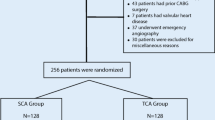Abstract
Restenosis remains a major limitation of coronary angioplasty in spite of major advances in techniques and technology. Recent studies have demonstrated that ionizing radiation may limit the degree of this problem. Gamma radiation has been shown to be effective in reducing in stent restenosis in humans, and beta radiation following encouraging results in animals has been shown to be feasible in humans. The objective of this study was to assess the feasibility of a 5 F non-centered catheter to deliver beta radiation emitting seeds to the lesion site post angioplasty and its effect on restenosis.
Following successful angioplasty, patients were randomized to treatment with 12, 14 or 16 Gy at the angioplasty site. This was delivered with a 5 F non-centered catheter. Twelve beta radiation emitting seeds (90Sr/Y) were delivered to an area 3 cm in length to cover the angioplasty site. Angiographic follow-up was performed at 6 months. Baseline and follow-up angiograms were performed by blinded investigators at a core laboratory.
This interim report comprises the first 35 patients to complete 6-month angiographic follow-up. There were no major radiation incidents. Four patients had evidence of angiographic restenosis. The MLD (mm) and percent stenosis were 0.77±0.27/72.5±8.6 pre angioplasty, 2.08±0.4/25.7±9.8 post angioplasty and radiation and 2.05±0.59/25.7±19.8 at follow-up respectively.
Conclusion: Beta radiation can be feasibly and safely delivered post coronary angioplasty with a very encouraging reduction of restenosis.
Zusammenfassung
Trotz größerer Fortschritte bleibt die Restenose die entscheidende Limitation der PTCA. Kürzlich durchgeführte Studien haben gezeigt, daß ionisierende Strahlen das Ausmaß dieses Problems begrenzen können. Gammastrahlung ist zur Reduktion der Instentrestenose auch bei Patienten effektiv, für Betastrahlen gibt es sowohl in Tieruntersuchungen als auch bei Patienten ermutigende Ergebnisse. Das Ziel dieser Studie war festzustellen, ob die Verwendung eines nicht zentrierten 5 F-Katheters zur Verabreichung von betastrahlenden Zylindern einen Effekt auf die Restenose nach PTCA aufweist.
Im Anschluß an eine erfolgreiche PTCA wurden die Patienten zur Behandlung mit 12, 14 oder 16 Gy randomisiert. Zwölf betastrahlende Zylinder («seeds») mit90Sr/Y wurden über eine Länge von 3 cm appliziert, um die PTCA-Stelle abzudecken. Die Kontrollangiographie erfolgte nach sechs Monaten. Die Auswertung der Ausgangs-und Kontrollangiogramme wurde entsprechend eines doppelblinden Protokolls durchgeführt.
Dieser Zwischenbericht umfaßt die ersten 35 Patienten, bei denen die Sechs-Monats-Kontrollangiographie durchgeführt wurde. Es gab keine größeren Strahlenunfälle. Bei vier Patienten kam es zu einer angiographisch definierten Restenose. Der minimale Lumendurchmesser (MLD) betrug 0,77±0,27 mm und die Durchmesserstenose 72,5±8,6% (vor PTCA), 2,08±0,4 mm und 25,7±9,8% nach PTCA und Bestrahlung sowie 2,05±0,59 mm und 25,7±19,8% bei Kontrollangiographie.
Schlußfolgerung
Eine Betabestrahlung kann einfach und sicher nach PTCA durchgeführt werden, die Ergebnisse zur Verhinderung der Restenose sind ermutigend.
Similar content being viewed by others
References
Carter A.J, Laird JR, Bailey LR, et al. Effects of endovascular rediation from a beta particle emitting stent in a porcine coronary restenosis model. Circulation 1996;94:2364–8.
Chaudry MR, Akhtar S, Duvalsaint F, et al. Ear lobe keloids, surgical excision followed by radiation therapy: a 10-year experience. Ear Nose Throat J 1994;73:779–81.
Condado JA, Waksman R, Gurdiel O, et al. Long-term angiographic and clinical outcome after percutaneous transluminal coronary angioplasty and intracoronary radiation therapy in humans. Circulation 1997;96:727–32.
Corn BW, Trock BJ, Goodman RL. Irradiation-related ischemic heart disease. J Clin Oncol 1990;8:741–50.
Coventry MB, Scanlon PW. The use of radiation to discourage ectopic bone: a nine-year study in surgery about the hip. J Bone Joint Surg [Am] 1981;63:201–8.
Cross WG, Ing WG, Freedman N. A short atlas of beta-ray spectra. Phys Med Biol 1983;28:1251–60.
Dangas G, Fuster V. Management of restenosis after coronary intervention. Am Heart J 1996;132:428–36.
Klein JL, Manoukian SV, Vogel RA, et al. for the Lovastatin Restenosis Trial Group. Computerized quantitative coronary arteriography: performance standards and edge detection. Am J Cardiol 1996;77:815–22.
Kovalic JJ, Perez CA. Radiation therapy following keloidectomy: a 20-year experience. Int J Radiat Oncol Biol Phys 1989;17:77–80.
Schopohl B, Liermann D, Pohlit LJ. 192 Ir endovascular radiation brachytherapy for avoidance of intimal hyperplasia after percutaneous transluminal angioplasty and stent implantation in peripheral vessels: 6 years of experience. Int J Radiat Oncol Biol Phys 1996;36:835–40.
Tardif J-C, Cote G, Lesperance J, et al. Probucol and multivitamins in the prevention of restenosis after coronary angioplasty. Multivitamins and Probucol Study Group. N Engl J Med 1997;337:365–72.
Teirstein P. Beta radiation to reduce restenosis. Circulation 1997;95:1095–7.
Teirstein PS, Massullo V, Jani S, et al. Catheter-based radiotherapy to inhibit restenosis after coronary stenting. N Engl J Med 1997;336:1697–703.
Verin V, Urban P, Popowski Y, et al. Feasibility of intracoronary beta radiation to reduce restenosis after balloon angioplasty. Circulation 1997;95:1138–44.
Waksman R, Robinson KA, Crocker IR, et al. Endovascular lowdose irradiation inhibits neointima formation after coronary artery balloon injury in swine. Circulation 1995;91:1533–9.
Waksman R, Robinson KA, Crocker IR, et al. Intracoronary lowdose beta-irradiation inhibits neointima formation after coronary artery balloon injury in the swine restenosis model. Circulation 1995;92:3025–31.
Weiderman JG, Marboe CH, Amols H, et al. Intracoronary irradiation markedly reduces restenosis after balloon angioplasty in a porcine model. J Am Coll Cardiol 1994;23:1491–8.
Author information
Authors and Affiliations
Corresponding author
Rights and permissions
About this article
Cite this article
Meerkin, D., Bonan, R., Crocker, I.R. et al. Efficacy of beta radiation in prevention of post-angioplasty restenosis. Herz 23, 356–361 (1998). https://doi.org/10.1007/BF03043600
Issue Date:
DOI: https://doi.org/10.1007/BF03043600




